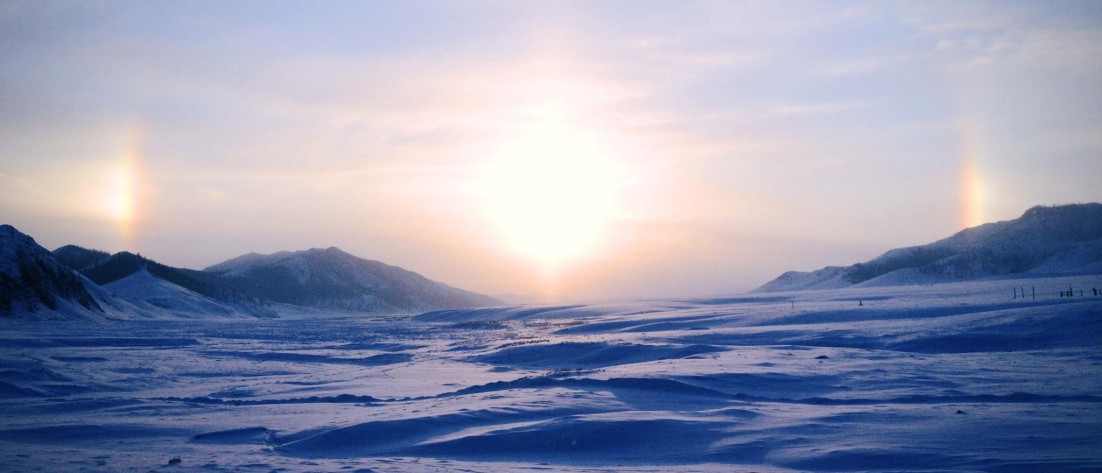Fast food, as we think of it, doesn’t really exist in Mongolia. I’m not just talking about American fast food, though that doesn’t really exist either; there is exactly one American food restaurant–not chain, but actual location–in the entire country. (And it’s not even McDonald’s!) Mongolia does have a fast food chain of its own, but while Khaan Buuz has a presence in many aimag centers, it’s a far cry from the ubiquity of chains here in the US. You can’t pull off the highway to grab a quick bite from a familiar name while driving from one city to the next, because 1) There are no highways; 2) There are only twenty-three cities in the country with a population greater than 10,000; and 3) Khaan Buuz doesn’t have non-city roadside locations. But even if the restaurant’s name isn’t instantly recognizable, its menu surely will be.
Mongolia might not have much in the way of “fast food,” but aside from celebratory dishes like khorkhog, it doesn’t really have “slow food” either. I’d be hard-pressed to count the number of times my roommate arrived home, hungry and hoping for a quick bite, while I was in the middle of cooking my own dinner. When this happened, I usually moved my food off the stove for the twenty minutes it would take her to finish cooking and resumed once she was done. It didn’t seem right to make her wait the hour it might take my split-pea soup to move from “crunchy” to “soupy” when all she was going to do was shave some mutton off of the chunk in the freezer and throw it in boiling water with noodles and salt. She and other Mongolians were often amazed by my cooking, even though the food I cooked wasn’t usually difficult to prepare. But by dint of using spices other than salt (and occasionally dill) and a more complex cooking process than heat-and-eat, my meals stood apart.
I would describe most Mongolian food as “utilitarian,” and гурилтай шөл (guriltai shöl, or soup with noodles) certainly exemplifies that characteristic. It’s one of several core Mongolian foods made from little more than meat, flour, salt, and water. Oh, and fat. Mongolians eat a lot of fat. Other typical Mongolian foods include:
- Бууз/buuz – steamed dumplings, typically filled with chopped mutton. My own version has chicken, vegetables, ginger, and sesame oil, which Mongolians find either delicious or heretical. Traditionally served at Tsagaan Sar. The variation known as мантуун бууз/mantuun buuz have a leavened dough.
- Хуушуур/khuushuur – fried dough pockets, more like empanadas than any American equivalent. Same dough and filling as buuz, flatter and fried instead of steamed. Traditionally served at Naadam.
- Цуйван/tsuivan – steam-fried noodles with meat and potatoes. City tsuivan often contains carrots, cabbage, onions, and sometimes beets, but countryside fare is usually more minimalist. Tsuivan is by far my favorite Mongolian food, but I have yet to produce a satisfactory batch in my own kitchen.
- Банш/bansh or банштай шөл/banshtai shöl – bansh are basically smaller buuz, only smaller and boiled rather than steamed. Banshtai shöl is soup with more meat, bansh, and a few vegetables. In addition to a more familiar soup, bansh are often served in сүүтэй цай/suutei tsai, or milk tea.
- Будаатай хуурга/budaatai khuurga – rice with fried meat and vegetables. Said vegetables may be limited to potatoes and onions, or they may include cabbage, peppers, and carrots.
These, in addition to Russian contributions like гуляш and mayonnaise-y салат (gulyash and salat, respectively, though gulyash bears a much closer resemblance to goulash than salat to salad), are the foods you’re most likely to encounter when eating in Mongolia, whether at home or on the road. Budaatai khuurga, tsuivan, and shöl come together in minutes; buuz, khuushuur, and bansh require a little more preparation. As a result, while all the foods listed above will probably be present on the menu of your standard roadside eating establishment, the non-dumpling options are more likely to be available.
These eating establishments, though not part of nation-wide franchises, are often similarly named. The signs above their doors might not bear names at all, but rather, labels: цайны газар, хоолны газар, зоогийн газар (tea place, food place, meal place). Despite independent ownership and operation, they are as generic as they are ubiquitous. If there is a substantial difference between a tea place and a meal place, I have yet to see it. Instead, I referred to any small eatery serving food fast and on the cheap by a more general term, borrowed from the Chinese: гуанз, or guanz.
If asked, the Mongolians I knew would translate guanz as “fast food,” but the term doesn’t carry the same distinction there as here. The phrase makes me think of burger joints and national franchises, of establishments I visit only when on the road and in a hurry. American fast food is industrialized, shipped cross-country and cooked using griddles, deep-fat fryers, and other equipment not usually found in home kitchens. It’s saturated in fat and, at least in affluent communities, often seen as an indulgence; most of us don’t eat burgers and fries every day. It’s “fast” because it’s typically frozen and requires no preparation beyond adding heat or hot water.
Mongolian guanz food, by contrast, is exactly what you’d find in a Mongolian home. The only thing that’s “fast” about it is that you didn’t have to cook it.


























